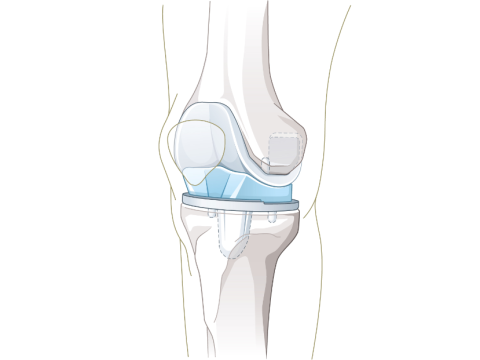Quality of everyday life thanks to research on the knee joint Research project
Our research team is taking a closer look at the bone. Specifically, we want to know what influence bone structure and bone quality have on the longevity of a knee prosthesis. We are looking for answers to the following questions: For which patients is a knee prosthesis the right treatment option? Which prosthesis is best for whom? And how long can the patient expect their knee prosthesis to last? Find out more about our current research project below. Initial results are already available.

”I hope that the data from this study will enable me to advise my patients more effectively.”
Dr. med. Stefan Preiss, Head of Knee Surgery
Knee prosthesis – the artificial knee joint
Patients with osteoarthritis of the knee suffer a great deal and this affects their everyday quality of life. Issues include knee pain, limited mobility and difficulty walking. Artificial knee joints, which replace the natural, worn sliding and surface areas of the knee joint, can offer relief. Every year, around 18,000 artificial knee joints are implanted in Switzerland, making it a widespread routine operation.
Foster new knowledge about bone structure and quality
In around 10% of cases worldwide, the knee prosthesis implant loosens prematurely. Partial knee prostheses are affected by this more frequently than total knee prostheses.
Although the cause has not been fully established, the consequences for patients are significant, as this requires revision surgery and another stint of rehabilitation. But what if we were able to scan the bone before the first operation and gain important insights relating to treatment and the choice of prosthesis? This is exactly where the research project comes in.
We want to know more about the influence of bone structure and bone quality on the longevity of a knee prosthesis.
The optimal treatment for every patient
In the future, the new findings from research will bring tangible benefits for practice, as bone analysis answers important questions:
- Is a knee prosthesis the right form of treatment for this patient?
- If so, which prosthesis is best for him or her?
- How long can the patient expect their knee prosthesis to last?
The answers to these questions help doctors choose the best treatment and allow them to advise and treat their patients in a way that is more tailored to their individual needs. This gives them the opportunity to improve the quality of life of many people. Knee joint research should benefit everyone, improve pre-operative diagnostics and set new standards in orthopaedic treatment.
Taking a closer look at the bone
We suspect that there is a relationship between implant loosening and bone structure at the time of surgery, and that changes in bone structure are the cause of pain. We are therefore working together with ETH to examine the affected bone parts at different points in time. To do this, we use a micro-CT scanner (micro-computed tomography) with a very high resolution.
In addition, we collect:
- objective data from MRI scans and X-rays to monitor things like implant loosening
- subjective data, such as pain
- data on influencing factors, such as patient characteristics that increase or reduce a favourable treatment outcome
- accidental findings and ancillary results
Treatment success from the patient’s perspective
Among other things, we use patient-oriented questionnaires before surgery as well as six months, one year and two years after surgery. This enables important comparisons to be made with respect to the success of treatment from the patient's perspective. The aim of outcome research is to optimise treatments and guarantee patient satisfaction. We use internationally recognised measuring instruments for data collection and evaluation.
Current status of research results
In a preliminary analysis, the implant-bone interface was found to be good or radiolucent in 21 patients who received radiographs six weeks after surgery. The same implant was cemented in all 21 patients. Cement penetration decreased with increasing bone fraction. After six weeks of surgery, four radiographs showed visible lines between bone and implant. Age and bone fraction had a significant effect on the frequency of these lines.
We will continue to monitor patients through the 2-year follow-up period. Loosening and other adverse events will be documented in our institutional registry. Some patients will be invited for clinical examinations.
Donate to research
Would you like to get involved in the future of medicine?
One of the main areas of activity of the Wilhelm Schulthess Foundation is the advancement of research, always with the aim of enabling patients to receive the best possible treatment. By donating to our research fund, you are directly supporting scientific training, research and development in the field of orthopaedics – a specific example being the “Quality of everyday life thanks to research on the knee joint" research project.
Find out more about how to donate:
Contact us
Would you like to know more about this project or other opportunities to support projects from the Research Fund or and Patient Assistance Fund ? We are looking forward to hearing from you.

